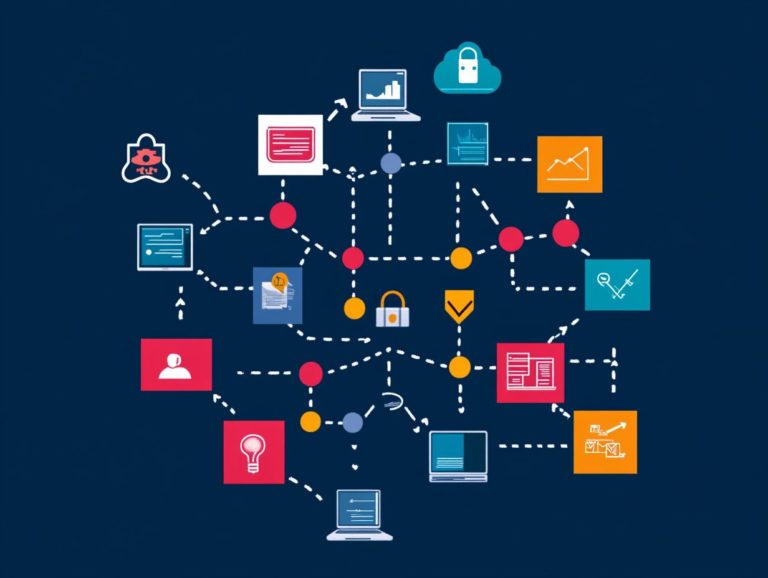What is Cloud Security Posture Management?
In today s digital landscape, securing your cloud environments is a major concern for organizations.
CSPM, a tool for improving cloud security, stands out as essential in this effort. It helps you manage your cloud security effectively.
This article explores CSPM, its purpose, and its importance in addressing the challenges of cloud security. You ll discover its key features like automated compliance monitoring and real-time visibility.
We ll examine how CSPM works, its numerous benefits, and why it s vital for enhancing security and efficiency in cloud computing.
Explore how CSPM can transform your cloud security strategy.
Contents
- Key Takeaways:
- Understanding CSPM
- The Importance of CSPM
- Key Features of CSPM
- How CSPM Works
- Benefits of Implementing CSPM
- Frequently Asked Questions
- What is Cloud Security Posture Management?
- Why is Cloud Security Posture Management important?
- How does Cloud Security Posture Management work?
- What are the benefits of using Cloud Security Posture Management?
- What types of organizations can benefit from Cloud Security Posture Management?
- Is Cloud Security Posture Management the same as Cloud Security?
Key Takeaways:

CSPM is a comprehensive approach to managing and securing cloud environments. It helps organizations tackle unique cloud security challenges.
Key features include automated compliance monitoring and real-time security visibility. This provides a proactive approach to managing your security posture.
Implementing CSPM offers benefits like enhanced security and compliance, cost savings, and greater efficiency in managing cloud security.
It’s an essential tool for any organization operating in the cloud.
Understanding CSPM
CSPM is a key part of your enterprise security strategy. It bolsters the security posture of your cloud environments.
As you adopt cloud-native applications and multi-cloud strategies, the risks from misconfigurations and security threats grow. CSPM provides automated assessments and insights, ensuring compliance with industry standards like PCI DSS (Payment Card Industry Data Security Standard), HIPAA (Health Insurance Portability and Accountability Act), and GDPR (General Data Protection Regulation).
Continuous monitoring allows your security teams to spot vulnerabilities and refine policies. This helps mitigate data breaches and enhances operational efficiency.
Definition and Purpose
CSPM focuses on elevating your cloud security. It offers a framework for continuous oversight and risk assessment.
With CSPM, you can identify vulnerabilities and misconfigurations in real-time. This ensures compliance with various regulatory standards and security policies.
Thanks to automated detection capabilities, CSPM allows you to manage potential threats proactively. You can swiftly address issues before they escalate into serious breaches.
By continuously analyzing your cloud settings, it provides insights into risk identification. This helps you maintain a resilient security posture.
In a world where cloud adoption is the norm and cyber threats are becoming more sophisticated, leveraging CSPM is essential.
This tool consolidates your security measures and automates compliance checks, making it crucial for organizations aiming to protect their assets.
The Importance of CSPM
The significance of CSPM cannot be overstated. It is essential for tackling the challenges organizations face in securing their cloud environments.
As cloud adoption grows, security teams must ensure their cloud infrastructure is free from misconfigurations and vulnerabilities. These could lead to serious incidents.
CSPM helps you visualize risks and identify compliance vulnerabilities. This enables effective incident response and resource allocation.
Addressing Cloud Security Challenges
Addressing cloud security challenges is crucial in today s digital landscape, where you must navigate many vulnerabilities arising from human error, misconfigurations, and ever-evolving security threats.
Cloud Security Posture Management (CSPM), a tool that helps manage cloud security, provides you with the tools necessary to proactively identify and resolve these issues before they escalate into serious security incidents.
As regulatory frameworks continue to evolve, maintaining compliance becomes a top priority for your organization. The pressure to adhere to standards like GDPR or HIPAA can feel overwhelming, but CSPM simplifies this process by automating compliance checks and ensuring your security posture aligns with industry requirements.
Continuous monitoring is another essential function, allowing you to receive real-time alerts about any deviations from expected security configurations. CSPM enables you to streamline your incident response processes and enhance visibility into your cloud environments. This not only mitigates risks but also cultivates a culture of accountability and vigilance throughout your organization.
Key Features of CSPM

Key features of Cloud Security Posture Management (CSPM) encompass automated compliance monitoring and real-time security visibility. These features enable your security teams to uphold a strong security posture in ever-changing cloud environments.
They allow for continuous monitoring and vulnerability detection. This ensures that you can quickly identify and address misconfigurations and security threats.
By adopting an API-driven approach, CSPM elevates multi-cloud visibility and integrates effortlessly within your DevOps processes, delivering context-rich alerts and actionable remediation guidance.
Automated Compliance Monitoring
Automated compliance monitoring is a crucial component of Cloud Security Posture Management (CSPM), enabling you to continuously evaluate your adherence to various compliance frameworks such as PCI DSS, HIPAA, and GDPR.
This capability allows your security team to pinpoint areas of non-compliance and offers actionable insights to address vulnerabilities before they can be exploited. By harnessing real-time data analysis and integrated reporting tools, you streamline compliance processes and alleviate the burden on your IT personnel.
This proactive approach enables you to align your security strategies with regulatory requirements. It fosters a culture of compliance that reduces the risks associated with potential breaches.
As a result, automated compliance monitoring significantly enhances your overall security posture, instilling confidence among stakeholders and protecting sensitive data.
These solutions also provide timely updates on regulatory changes, allowing your organization to adapt swiftly and maintain compliance in an ever-evolving landscape.
Real-time Security Visibility
Real-time security visibility is crucial for effective risk visualization in your Cloud Security Posture Management (CSPM). It allows your security team to continuously monitor cloud environments.
This capability enables the immediate identification of anomalies and potential security threats. It ensures you take a proactive stance on incident response and mitigation.
By integrating advanced analytics and machine learning techniques, you enhance your team s ability to correlate data from various sources and detect vulnerabilities that might otherwise slip through the cracks.
This continuous surveillance helps you respond to incidents faster, keeping your data safer. It also provides decision-makers with valuable insights into the security posture.
Collaborative tools further streamline communication among your teams, elevating the overall security strategy and reducing vulnerabilities within your cloud infrastructure.
Ultimately, embracing real-time visibility cultivates a culture of vigilance, ensuring that security remains a top priority in an ever-evolving digital landscape.
How CSPM Works
CSPM operates by utilizing a suite of sophisticated deployment and integration tools, designed to ensure a smooth integration into your existing IT security landscape.
Once implemented, CSPM continuously monitors your cloud environments, providing timely remediation guidance for identified vulnerabilities. This proactive approach enables your organization to maintain a resilient security posture in the face of ever-evolving threats.
Deployment and Integration
The deployment and integration of Cloud Security Posture Management (CSPM) are crucial for your success. It enables you to embed security seamlessly into your DevOps processes.
By leveraging a way to manage cloud resources using code principles, you can integrate CSPM effortlessly with your CI/CD pipelines. This ensures that security measures are woven throughout the entire development lifecycle.
To start, assess your current cloud security posture. Pinpoint potential risks and vulnerabilities. Next, choose the CSPM tools that best align with your operational needs and compliance requirements.
Integrating these tools into your existing workflows is essential. This often involves APIs to connect security measures with your DevOps platforms.
By implementing security best practices early in the development phase, you enhance operational efficiency. This minimizes the chances of serious vulnerabilities making their way into production.
Ultimately, the proactive approach of CSPM not only strengthens your security posture but also cultivates a culture of accountability within your development and operations teams.
Continuous Monitoring and Remediation

Continuous monitoring and remediation are essential elements of your CSPM strategy. This enables you to stay one step ahead of potential security incidents.
By consistently evaluating your cloud infrastructure, CSPM helps identify risks and offers remediation guidance. This ensures vulnerabilities are addressed before they can be exploited.
This proactive approach not only reduces the chances of data breaches but also guarantees compliance with regulatory standards. For example, with automated checks, you can swiftly detect misconfigured security settings common threats in cloud environments.
CSPM tools provide real-time visibility into your security metrics. This enables you to prioritize remediation efforts based on the level of risk.
By cultivating a culture of continuous assessment and improvement, you can significantly bolster your security posture. This effectively manages both known and emerging vulnerabilities in an increasingly complex cloud landscape.
Benefits of Implementing CSPM
Implementing CSPM brings a wealth of advantages that can profoundly elevate your organization’s security and compliance stance.
Get ready to discover how CSPM delivers powerful insights that keep you ahead of risks! By providing context-aware insights and automated assessments, CSPM enables your security teams to proactively pinpoint vulnerabilities and effectively mitigate risks.
This heightened level of vigilance not only safeguards your cloud infrastructure against data breaches but also translates into significant cost savings and enhanced operational efficiency.
Enhanced Security and Compliance
Enhanced security and compliance are key advantages of adopting CSPM. This enables you to effectively mitigate risks associated with your cloud environments.
CSPM equips you with tools for risk visualization. This enables your security teams to identify and rectify vulnerabilities while ensuring adherence to essential compliance frameworks.
By implementing CSPM, you can continuously monitor your cloud configurations. It automatically flags any misconfigurations or deviations that could lead to security threats like data breaches or unauthorized access.
For instance, in environments such as AWS or Azure, CSPM swiftly spots security group rules that mistakenly expose sensitive resources. This is crucial for protecting your data!
CSPM also plays a vital role in meeting compliance requirements outlined by various regulations. It allows you to conduct audits with ease, ensuring that you remain compliant with standards like GDPR or HIPAA.
As you migrate more services to the cloud, adopting a CSPM strategy becomes critical for safeguarding your assets and steering clear of compliance pitfalls.
Cost Savings and Efficiency
Cost savings and operational efficiency are significant benefits of Cloud Security Posture Management (CSPM). This enables you to allocate resources wisely while minimizing security risks.
By automating compliance monitoring and risk assessments, CSPM reduces the reliance on manual oversight. This approach boosts your security while driving down operational costs.
This streamlined approach also liberates your IT personnel to concentrate on higher-value tasks, ultimately maximizing workforce productivity.
You also gain real-time insights that enable swift identification of vulnerabilities and prompt responses to potential threats. This significantly lowers the risk of costly breaches.
With improved resource management, you can optimize your cloud expenditures. This ensures your investments align seamlessly with security priorities.
Integrating CSPM solutions creates a dynamic security environment that promotes financial efficiency and strong operations.
Frequently Asked Questions
What is Cloud Security Posture Management?

Cloud Security Posture Management, also known as CSPM, is a set of policies, technologies, and processes used to ensure the security of cloud computing environments. It involves continuously monitoring and managing the security posture of all assets within a cloud environment.
Why is Cloud Security Posture Management important?
With the increasing use of cloud computing, organizations face numerous security challenges. CSPM is important because it helps identify and address potential security risks and vulnerabilities in a cloud environment.
This ensures the confidentiality, integrity, and availability of data and applications stored in the cloud.
How does Cloud Security Posture Management work?
CSPM works by continuously scanning and analyzing the configurations of cloud resources. It compares them to industry best practices and compliance standards.
Any security risks or misconfigurations are then identified and remediated to maintain a secure cloud environment.
What are the benefits of using Cloud Security Posture Management?
Implementing CSPM provides several benefits, including improved visibility and control over cloud resources. It also increases compliance with security standards and regulations.
Moreover, it reduces the risk of data breaches and cyber attacks while streamlining security management processes to minimize human error.
What types of organizations can benefit from Cloud Security Posture Management?
Any organization that utilizes cloud computing can benefit from CSPM. This includes small businesses, large enterprises, and government agencies.
It is especially beneficial for organizations that deal with sensitive or regulated data, such as financial institutions, healthcare providers, and government agencies.
Is Cloud Security Posture Management the same as Cloud Security?
No, CSPM is not the same as Cloud Security. While Cloud Security refers to the overall protection of cloud environments, CSPM specifically focuses on managing and maintaining the security posture of those environments.
It is one aspect of a comprehensive cloud security strategy.
Ready to enhance your cloud security? Explore our CSPM solutions today!






